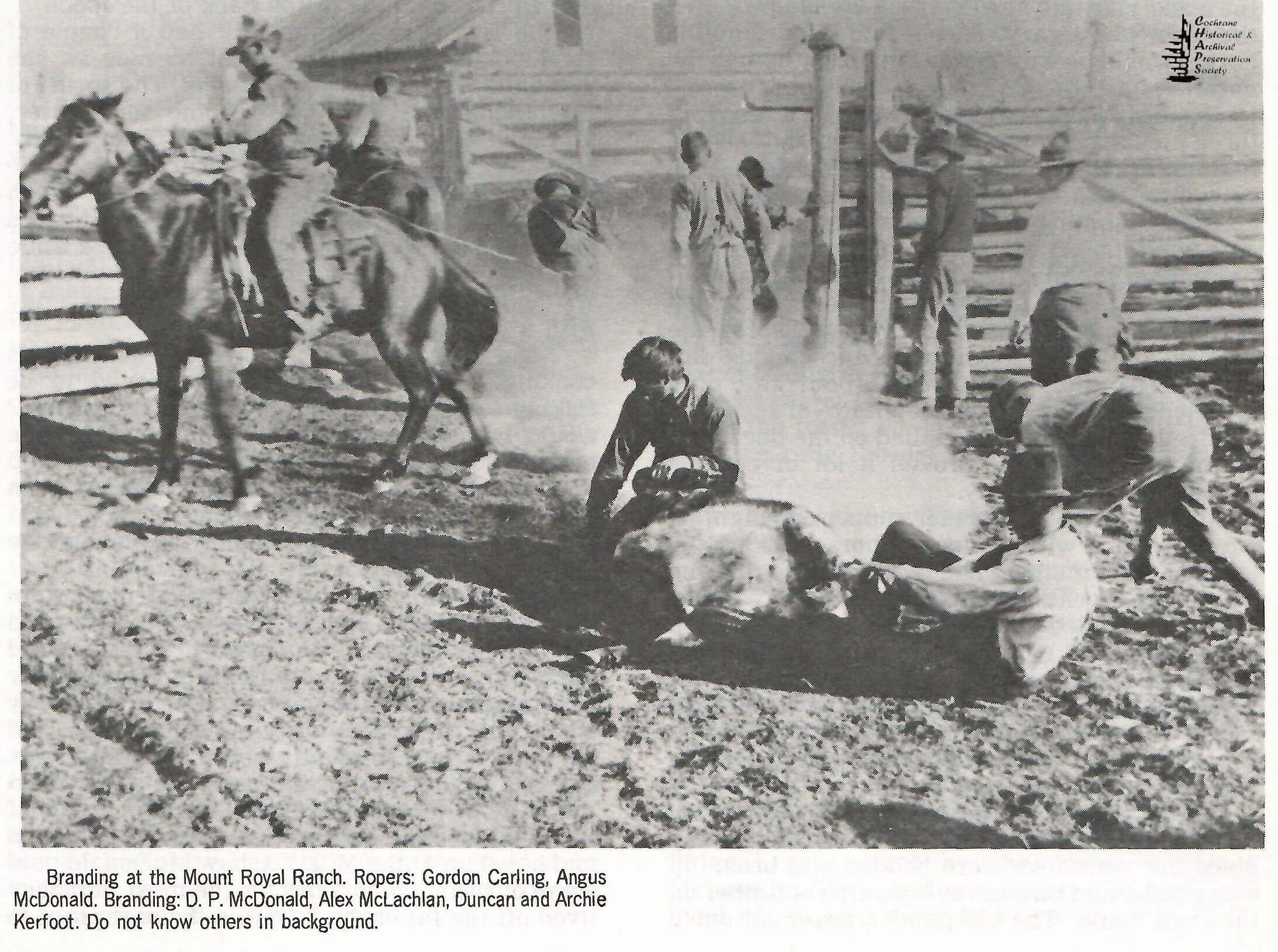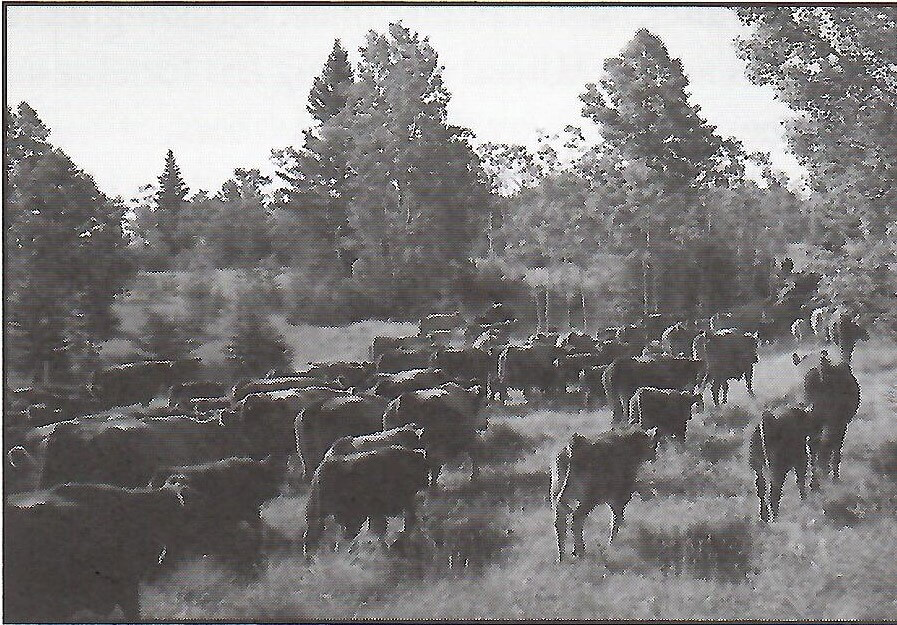Excerpt from thesis of D.E. Brown U. of A. 1951
In the spring of 1881, plans were made to purchase the first herd of cattle for the Cochrane Ranche. Major Walker was sent to Montana, where he obtained six thousand eight hundred head at an average price of eighteen dollars per head with the understanding that the Montana ranchers from whom they were bought would deliver them to the boundary.
The I. G. Baker Company contracted to drive the cattle from the boundary to the Cochrane ranch for two dollars and fifty cents per head. Frank Strong, a foreman for the Baker Company, was in charge of the drive and was assisted by thirty cowboys with three hundred head of horses. In order to make as rapid a trip as possible, Strong divided the herd in two. The “dry” herd, consisting of steers, was sent ahead and was driven at the rate of fifteen or more miles per day.
The second group made up of cows and calves, was moved more slowly although it often covered fourteen miles in a day, Kelly says that “this drive has remained the criterion for hard-driving, and no such great numbers of cattle have since been moved so rapidly by trail”. The number of wagons came along behind the herds to pick up the calves that had fallen from exhaustion, hundreds of cattle were left to perish along the way. The herds were pushed across the Bow River near the site of the present Mewata Park in Calgary and turned over to Major Walker and his men.
Several of the Baker cowboys remained to work for Major Walker and quite a number of the saddle horses were sold to the Cochrane Ranche Company. The Baker Company had contracted to brand the cattle before turning them over to Major Walker but had been unable to do so because of the speed with which the drive was carried out. As a result, the cattle were accepted after a hair brand and proper branding was to be given at the home ranch. It was late in the fall when the herd arrived, however, and branding was postponed until the following spring. Winter came on before the cattle had a chance to recover from the hard drive and, although it was not an unusually cold winter, many died.
The drive and the effect of the winter on the herd provided valuable information to the cattlemen of the west on the relative endurance of the various breeds of cattle. Black Polled Angus cattle proved most sturdy, Herefords rated second and Shorthorns were the least hardy. In the spring of 1882, the hair brand that had been put on the cattle the previous fall disappeared with their winter coats.
The Company directors ordered Major Walker to round up every unbranded animal on the Cochrane range and brand it with the Cochrane 11CH. Several settlers in the area assisted for a time but, when they found that their own unbranded animals that were on the Cochrane range were to be included in the round-up, they quit in a body. The settlers were incensed at the prospect of losing their own cattle and, in order to avoid financial ruin, they set to work searching for scattered groups of cattle that had been missed in coulees and ravines during the general round-up. Any that were found were taken home and branded with the settler*s own brand. Quite a number of cattle ended up with the wrong brand and It is not unlikely that the settlers came out with somewhat augmented herds.
Major Walker had been hampered in his management of the ranch on several occasions by the necessity of obeying orders from the company’s office in the east or from Dr. McEachren, who was his immediate superior and also manager of the Walrond ranch further south. These orders were often ill-advised since they were not based on sound ranching experience nor in accord with the conditions existing on the ranch itself at the time. During a trip to Montana in the summer of 1882, Major Walker was forced to follow a course of action that he found entirely against his better judgment and as a result, he tendered his resignation. Major Walker had arranged for the purchase of four thousand three hundred head of cattle from the Poindexter and Orr ranch in Montana. The deal was temporarily suspended when Dr. McEachren arranged for the purchase of the new herd by the I. G. Baker Company. This Company was planning to stock an Alberta ranch for itself and Dr. McEachren felt that the Cochrane herd could be more profitably purchased in conjunction with the Baker herd. The arrangements were tentative and opposed by Major Walker. The Baker Company finally abandoned the idea and Major Walker returned to the Poindexter and Orr ranch to find that the price of cattle had risen in his absence. The herd cost twenty-five thousand dollars more than it would have if the deal had been completed earlier and valuable time had been lost.
Major Walker. was so incensed that he sent in his resignation, to take effect when a successor could be found. Poindexter and Orr undertook to deliver the new herd to the Cochrane ranch at a cost of two dollars and seventy-five cents per head. Deliveries were to begin July 1, but several delays occurred and the herd did not arrive until October. Poindexter was in charge of the drive and found it necessary to move rapidly to avoid being caught by an early snowstorm. The plan failed. At Fish Creek, near the present Midnapore, the weary herd ran into a bitter snowstorm and could proceed no further. Poindexter wanted to hold the animals there for a month until they had recovered from the long drive and the snow cleared, but Major Walker, acting on orders from the east, insisted that delivery be carried out as soon as possible.
Poindexter obtained a number of hardy steers from nearby settlers and sent them ahead to break a trail through the snowdrifts. The exhausted Cochrane herd was forced along behind them. The cattle were turned over to Major Walker on October 20. Poindexter was an experienced rancher but had been forced to move the herd too fast owing to the delay in purchasing it and was later forced to continue the drive after the snowfall because of the orders from the Cochrane Ranche Company directors, however, the Company had begun to learn a lesson. In a contract with the I. G. Baker Company signed on September 5, 1882, the Cochrane Ranche Company agreed to pay forty dollars per head for some four hundred and fifty to five hundred and fifty head of three-year-old steers, at the same time specifying that the herd was to be delivered to the Cochrane ranch and the drive was not to occupy less than three weeks.
On September 7, 1882, Frank White, a former railroad man and bookkeeper, arrived at the Cochrane ranch to assume the duties of treasurer. On October 7, Mr. W. D. Kerfoot, a Virginian and an experienced rancher, arrived to take charge of the livestock and replace Major Walker. Major Walker subsequently established a very successful lumber business in Calgary. The winter of 1882-83 was a disastrous one for the Cochrane ranch. The storm mentioned above lasted until October 13 and was followed by a slight thaw that softened the snow. This thaw was followed by a severe cold spell and a hard crust formed on the snow. The cattle found it impossible to reach the grass and drifted continually. The directors in the east were advised of the condition of the range and the lack of feed but insisted that the stock be held on the Cochrane lease.
Camps of cowboys were established at the mouth of the Fish creek, at Calgary and along Nose creek to hold the herd. The whole winter was spent in holding the starving herd on the home range. This blundering policy was followed in spite of the fact that there was excellent winter range at Blackfoot Crossing and the Little Bow where only a small amount of snow fell throughout the winter. The winter of 1881-82 had been rather mild and the Cochrane herd had come through it without serious losses. As a result, no preparation had been made for the following winter. No hay had been put up and no one seems to have considered the possibility of a hard winter and the disastrous effect that such a winter would have on the cattle. The inability of the local manager to follow his own initiative compounded the disaster.
The extent of the losses of Cochrane cattle was not fully appreciated until June 1883, when the snow finally disappeared. Kelly, describing the Cochrane losses, says, “Dead bodies were heaped in every coulee, thousands of head having perished. Some of the long ravines were so filled with carcasses that a man could go from the top to the bottom, throughout its entire length, and never have to step off a dead body.
Indians made a very good wage for some time, skinning the animals for twenty-five cents each. Out of the twelve thousand head that had been purchased and placed on the Cochrane range, there remained now but a scant four thousand, counting natural increase.” Other ranches in southern Alberta suffered but a fraction of the losses of the Cochrane Ranche chiefly because of a more practical policy of letting the cattle drift to areas where they could graze.
In 1882 the Cochrane Ranche Company started a butcher shop in Calgary as a retail outlet for their beef. A camp was established at Nose Creek to hold the cattle for this shop and also to supply the beef required to fill the North West Mounted Police contract. About twenty steers a month were sold from this camp. Another camp at the Sarcee reserve supplied the twenty-five head per month required to feed the Indians there.
There were two other camps as well, one at Blackfoot Crossing, which supplied one hundred and thirty head per month to the Blackfoot Indians, and a second one at Morleyville, where twenty head of cattle were required each month for the Stoney.
In the spring of 1883, the directors of the Cochrane Ranche Company decided that the winters in the area west of Calgary were too rigorous and a new lease was taken up in the Waterton Lakes area, southwest of Macleod. This new ranch was made up of land taken over from the ’’Rocky Mountain Cattle Company” and the ’’Eastern Township Ranch Company”,





